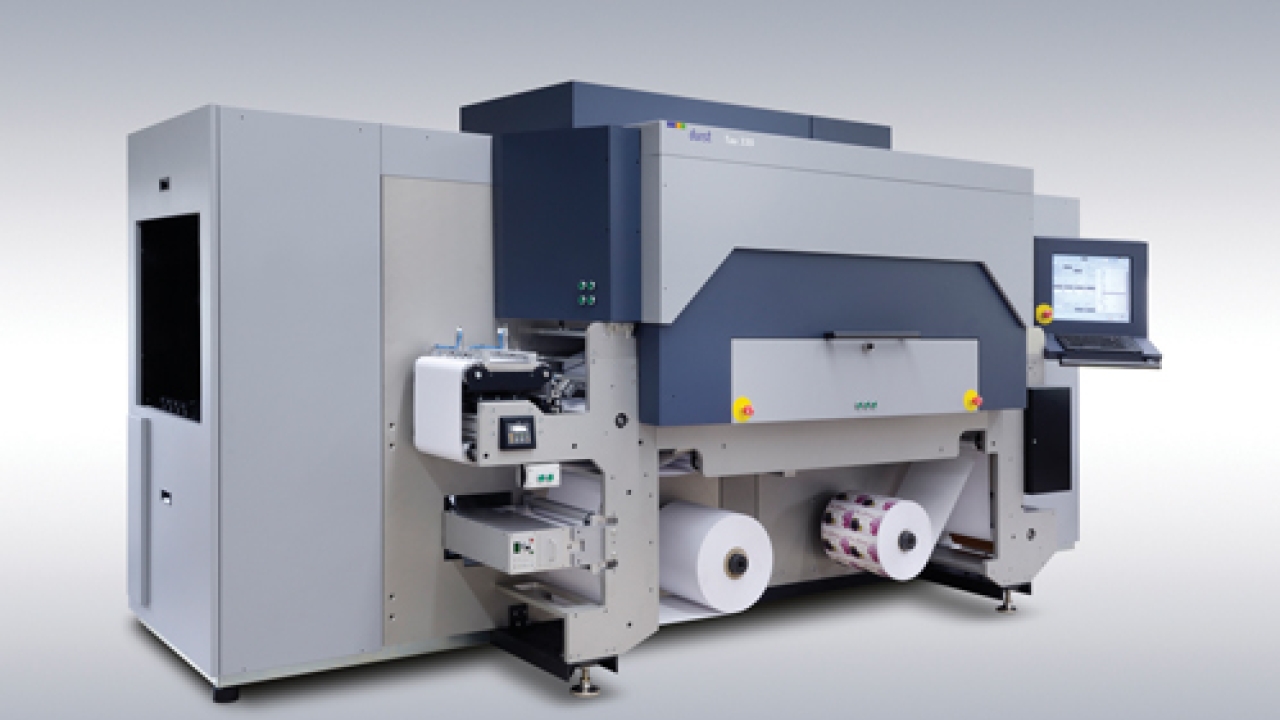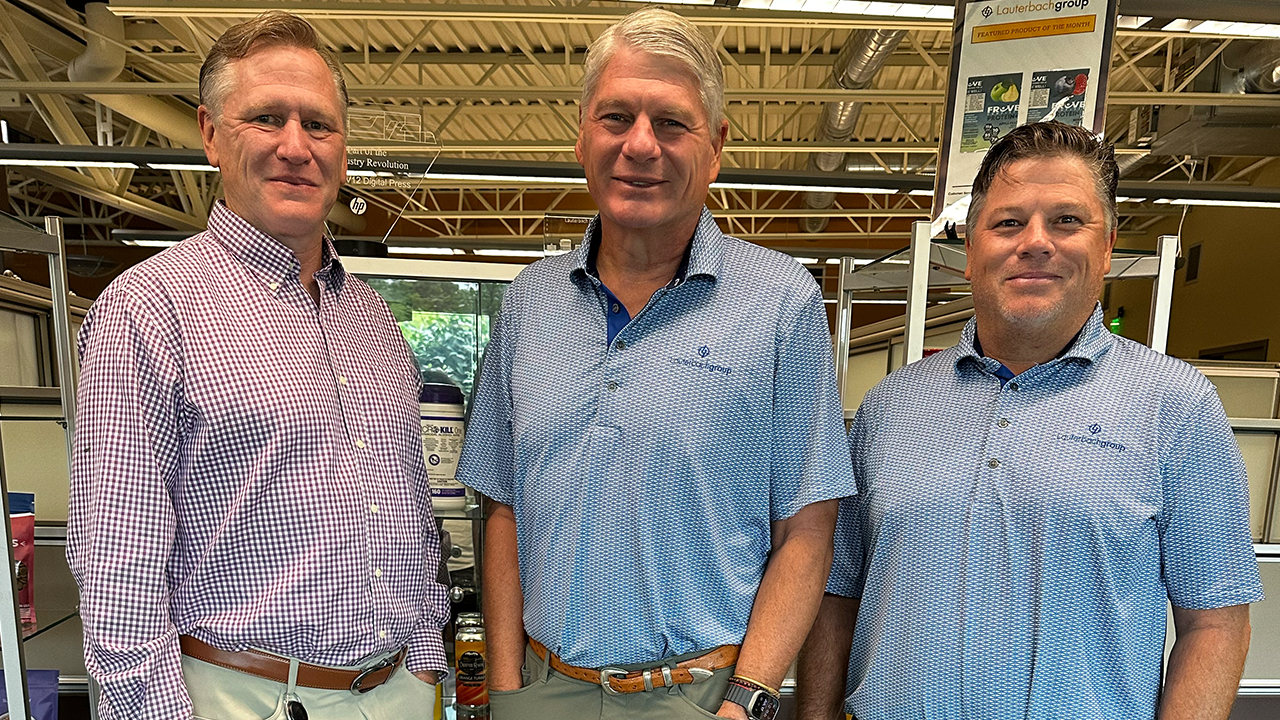No slowing in the inkjet pace

Higher resolutions, wider presses and more colors are key inkjet trends, writes Barry Hunt
At last year's Labelexpo Europe inkjet press vendors confidently talked about targeting flexo printers. Some emphasized inkjet's versatility and its flexo-like quality, while others mentioned the lower set-up costs of a basically plateless process. With certain reservations, the inkjet fraternity has indeed delivered the goods. Modern systems have raised overall quality standards for both primary labels, as well as shrink sleeves and other flexible packaging. Besides CMYK, many single-pass machines now include options for opaque white ink and specific hexachromic colors for extended color gamuts.
Drupa 2012 helped to accelerate this progress. Notable developments included the launch of several sheet-fed inkjet presses for producing folding cartons and other packaging. The huge show also reflected an industry-wide trend towards strategic partnerships between conventional press makers and all types of digital printing vendors, including the market for inline hybrid inkjet/flexo presses with integral converting facilities.
Drop-on-demand CMYK printheads can achieve smooth gradations and broad tonal ranges on a variety of substrates. Many can deliver print speeds of 50 m/min or higher, depending upon resolutions and grayscale levels. An example is Xaar's 1001 piezoelectric head, which remains the most widely used: at least eight different vendors demonstrated Xaar-equipped print engines at the show. The Cambridge-based company's Hybrid Side-Shooter architecture gives a native resolution of 720 x 360 dpi. Six to eight grayscale levels extend this to an apparent 1,000 dpi image resolution.
Challenging Xaar's dominant narrow web position are established giants like Kyocera. It has introduced its KJ4B-Y heads for water-based inks and KJ4A-B heads for UV-curable inks. The later can print one-and-a-half times faster than previous Kyocera types, delivering 80 million drops/second from 2,656 nozzles for high-speed, high-resolution printing on paper or filmic label stocks. Both models print with a resolution of 600 x 600dpi, with a width of 4.25 inches, at one head for feed direction.
Cambridge-based Industrial Inkjet (IIJ) featured Konica Minolta's KM1024iMH printhead with its new ColourPrint 142 (142mm wide head) label press to join an existing 72mm model. As one of the latest ‘I’ series, the new printhead achieves a top print speed of 75m/min at 360 x 720dpi using three gray levels. It prints CMYK, mono, and white/varnish in widths from 36mm to 352mm. IIJ, which has a technical partnership with KM, also launched the XYPrint 200 stand-alone module fitted with either KM512 or KM1024 printheads. It is a type of test rig for process development for product decoration or materials deposition, or for investigating UV curing properties, with an option for LED pinning.
Memjet's printheads are associated with wide-format inkjet printer/cutters, such as the Roland VersaUV series. They also feature on Colordyne Technologies' new CDT-1600 PC Sprint label press. It has five printheads – CMYK plus spot color – stacked in a row, rather than across the web to give a single-pass speed up to 49 m/min (160 ft/min) on a 10-inch web. Each printhead contain 70,400 nozzles and print with water-based inks to give a claimed resolution of 1,600 x 1,200dpi. The roll-to-roll press uses an AzTech web platform and can run with pre-die-cut labels.
Reflecting the wider acceptance of single-pass inkjet printing, Agfa has revamped its Agora and Altamira UV-curable inks to cover a broader range of label and packaging applications. The different formulations involve partnerships with piezoelectric printhead manufacturers to meet the demands of system integrators and OEMs for specific market sectors. In a similar vein, EFI Jetrion's ink division reports a 'significant increase' in year-on-year UV-curable ink sales. Apparently Jetrion users are experiencing rapid growth and an accelerated rate of innovative applications.
Interestingly, we are seeing more inkjet presses that include UV LED curing, rather than curing with traditional mercury UV lamps. A much lower heat generation without IR light emissions makes it ideal for printing heat-sensitive substrates on compact inkjet presses. Honle Group showed the LED Powerline array for pinning – a partial inter-color cure – and final curing of inkjet printing. Phoseon Technology introduced the FireFly FF200 25 x 20mm and 50 x 20mm air-cooled lamps with an output of 4 W/cm². The FE200 has half the Wattage for pinning purposes. Phoseon's more powerful FirePower UV LED lamps are suitable for UV flexo production using inks and coatings from Flint Group.
The growth in demand for LED-cured inks prompted Bordeaux to introduce a 9-color series, including white, to suit specific printheads and curing rates. The Israeli ink maker also supplies conventional UV inks and coatings, as well as water-based inks and coatings for wide-format printer/cutters. Its new Latex inks achieve the same quality levels of solvent-based inks, but offer the environmental advantage of water-based inks. They are customized for specific printers or printhead technologies.
Press developments
Screen marked its entry into roll-fed labels with a prototype Truepress Jet L350UV. It joins a new sheet-fed inkjet press for producing folded cartons. The maximum speed is 50m/min for web widths of 322mm and 350 mm. Multi-level grayscale printheads are augmented with Screen's high definition inks and proprietary high-resolution screening to obtain a wide color gamut. The package includes Screen's Equios Universal Workflow color management technology. The L350UV will be seen at Labelexo Americas, by which time a white ink unit may be available.
EFI Jetrion has begun installing the 4900, following its Labelexpo Europe debut. The CMYK, plus opaque white, print engine uses Xaar 1001 printheads. It was the first inkjet press to combine a laser cutter (a dual-head system from SEI Laser Converting). This slows speeds to a maximum 24 m/min, but users obtain print-to-cut production with shorter setup times, lower material consumption, including that of durable substrates, and reduced stock-holding.
Inx International Ink’s new NW140 UV (part of Evolve Advanced Digital Solutions) also offers laser cutting within a print-to-converting operation based on Spartanics' X140 dual-head unit. The press uses 14 Xaar 1001 printheads at a top rate of 80 feet/min (24 m/min) on any label stock. Like some newer models, it uses water-cooled UV LED curing. Phoseon Fireline 225 lamps and an air-cooled UV LED pinning system from Integration Technology are fitted. Typically, they allow users to pre-coat with a white base layer and varnish to hold the inkjet drops in position before completing a full cure prior to laser cutting. The NW140 supports media up to 2mm thick on 3-inch cores up to two feet in diameter. Its public debut is at Labelexpo Americas.
Domino's N600i is now in commercial production following previous Labelexpo outings. It claims one of the smallest drop sizes on the market using Kyocera printheads. They give a 600dpi resolution with up to four grayscale levels for high quality results on paper or filmic substrates. A top speed of 75 m/min (246 ft/min) equates to 1,500 sqm/hour (16,000 sq ft/hour). The N600i has several automated features to reduce manual intervention for faster job changes and achieve consistent print quality.
Durst's new Tau 330 is a wider version of previous models. It prints up to 48 m/min for an hourly production rate of 950 sq/m on a web width of 330mm. Opaque white, plus hexachromic orange and violet, are color options. The RIP software incorporates substrate and color management. The Tau 330/200 version has a web width of 200mm, and also uses Xaar 1001 printheads. The new Tau 330 Variable Data Print option allows users to insert reels of die-cut and pre-printed labels, while printing at the same rate as the host press. The company offers durable Tau UV inks for labeling consumer electronic equipment, including computers, garden equipment and power tools.
The Linoprint L forms the basis for Heidelberg's move into inkjet label printing. It was formerly the iTS600 from CSAT, which Heidelberg acquired in August 2011. In its original form the press used Xaar 1001 four-level grayscale printheads to deliver a 600dpi x 600dpi resolution with four print widths up to 420 mm at speeds of up to 48 m/min. Phoseon's LED curing system was used. The Linoprint L prints labels, flexible packaging and blister foils. It can either be operated as a standalone machine or integrated into packaging lines as a separate system with a feeder device. It includes variable data and anti-counterfeiting features.
Stork Prints' latest DSI 5330L UV inkjet press handles short-to-medium runs of premium labels at up to 35 m/min, equal to 700 sq/m an hour. CMYK print units using Xaar 1001 printheads are standard, but the newly-designed modular platform allows up to 10 print stations to include white and hexachromic orange and violet. Stork Prints’ own-brand inks offer high levels of light resistance and scratch-proofing. A visual resolution up to 1,000dpi, 3D effects that resemble screen printing, and multi-substrate tonal values down to 1 percent tonal are claimed. A new primer unit allows printing on machine-coated paper. Repeat lengths of up to seven meters are possible. The press can also run inline with semi-rotary converting units.
Epson introduced the L-4033AW, a seven-color version of the existing multi-pass SurePress. The AQ pigment ink set includes opaque white for printing on films or metallic labels stocks, as well as hexachromic orange and green for an extended color gamut. The variable-size droplet technology of Epson's thin film printheads enables smooth gradations and optimum image quality. The company showed a prototype single-pass press, the SurePress X, which uses the same micro piezo printheads. It is fitted with LED UV curing lamps for printing short and mid-run paper and filmic labels.
The first Chinese digital inkjet press is the EagleJet L1400, introduced by Founder Electronics. It uses Xaar 1001 printheads and augments the company's EagleJet P5200 wide-format, full-color model for print-on-demand books and transactional print. Both devices are supported by Pasharp software with trapping tools, specialized step-and-repeat, and a series of editing tools. PhotoPack is based on Adobe Photoshop for dealing with complex image processing, including trapping, line extraction and color separation functions.
Inkjet printing is synonymous with the individual coding and serializing of all forms of packaging. Atlantic Zeiser's Digiline Web 300 extends the concept to include security features by integrating its Delta 105i and Omega 36i high-speed inkjet printers. The Digiline Sheet 300 uses an Omega 36i printer. Both systems use AZ's Smartcure Air UV LED curing system. A partnership with press maker KBA see the integration of Delta 105i modules on Rapida 105 sheet-fed offset presses for coding sheets, including labels, and flat packaging. AZ's Vericam verification system can be optionally integrated.
Hybrid inkjet/flexo
FFEI introduced a separate white/spot color print unit for placing before or after the CMYK Caslon print engine. Cambridge-based FFEI also featured an upgrade to the RealPro Workflow software. The Caslon was jointly developed with Nilpeter. Both companies share the sales and marketing functions. Nilpeter typically sells the Caslon as part of a hybrid press with FA-4 UV flexo print units, die-cutting and other finishing units in web widths up to 420mm. Caslon's top speed is 25m/min or 50m/min depending on resolutions using Xaar 1001 printheads. Nilpeter has installed 15 Caslon hybrid lines since its introduction five years ago. Caslon units also operate in a stand-alone mode using Nilpeter's FA Line web transport system.
From the oldest hybrid press to the newest: the d-Flex from Focus Label Machinery. It prints CMYK with an optional opaque white at up to 50 m/min using Konica Minolta printheads. LED UV curing allows printing on clear and metallic films. The press is available in widths of 142mm, 250mm and 330mm. The press includes inline servo-driven flexo units, die-cutting, cold foiling, laminating and varnishing in roll-to-roll or roll-to-sheet formats. Offline overprinting and varnishing with accurate re-registration at 100m/min is possible. The d-Flex package includes software and a RIP with variable data and color management.
Omet launched the CMYK JetPlus inkjet module, shown integrated with an 8-color XFlex X6 430 combination press. It can also run inline with Varyflex V2 platform presses for flexible packaging, at a claimed average speed of 60m/min. The JetPlus module allows users to switch between digital printing and UV flexo printing according to run lengths with end-to-end production. This includes Omet's Monotwin Cut die-cutting system, which is said to reduce downtimes for die or cylinder changes. JetPlus includes an automatic washing system that prevents the ink from drying during stoppages.
Sheet-fed inkjet
Drupa 2012 will be remembered for the emergence of sheet-fed inkjet presses for producing folded full-color cartons and print-on-demand packaging applications to a B2 format (500 x 707mm or 19.66 x 27.83 inches). Examples include Fujifilm's new Jet Press 720 fitted with the company's Samba printhead technology. Using water-based pigment inks, it prints process colors at 1,200 dpi resolution with four levels of grayscale for an extended color gamut. Fujifilm claims offset-type quality for print runs of less than 100 units upwards, including paper and filmic prime labels.
MGI Digital Technology displayed another sheet-fed prototype. The French company's Alphajet B2-format press offers six colors and spot UV-cured coatings (of the type offered for its JETvarnish and JETcard products). The Alphajet prints at up to 3,000 sheets/hour in resolutions of up to 1,200 x 1,200dpi. The press offers full variable data printing and handles carton board up to 500gsm.
Screen's Truepress JetSX folding carton press, developed from an existing print-on-demand model, uses multi-level grayscale printheads with water-based pigment inks to print standard offset and inkjet papers and boards up to 0.6mm thick. The top speed of 1,620 sheets/hour is equivalent to 108 A4 pages per minute. Files received online can be automatically preflighted, color managed, imposed and placed in the print queue. Screen's Equios front-end can interface with MIS to generate automatic billing if required.
Konica Minolta IJ Technologies showed the KM-1, a prototype B2 format press jointly developed with Komori, the offset press manufacturer. Ostensibly aimed at the commercial printers, the press also has label and package print capabilities. The inkjet print engine is fitted with KM's latest printheads with UV LED curing. The KM-1's top speed is 3,300 sph (simplex) and 1,650 sph (duplex) at a print resolution of 1,200 x 1,200dpi.
Generally speaking, any expectancy for high levels of quality and productivity must be backed by consistency of results, especially where packaging for global brands is concerned. This implies a wider use of color measurement systems and calibration tools, such as GMG's OpenColor. As a proofing tool it simulates the combined printing of spot and process colors. GMG also offers a cloud-based service for professional media and users, that promises to redefine how color management is used in the future. X-Rite with its Pantone subsidiary, has launched PantoneLive as another cloud-based service intended to achieve repeatable and accurate color for packaging across a variety of substrate types. PantoneLive applications range from brand owners and designers through to pressroom operators, and includes enhanced Pantone color libraries.
Developments like these, plus the many strategic partnerships that have recently emerged, reinforce vendors' efforts to establish inkjet printing as a valid short-run process for labels and packaging. Of course, other digital technologies are keen to retain their strong market positions. In fact HP Indigo and Xeikon both introduced new generations of dedicated electrophotographic (EP) label and packaging presses. Xeikon has additionally introduced Trillium. Based on a new liquid image development system, it is said to combine EP's high quality with the higher speed and lower cost of inkjet. Also launched at Drupa was the highly significant nanographic printing technology from the Landa Corporation for short-run CMYK printing on either web or sheet-fed machines (as explained elsewhere). Strategic partnerships, currently involving Komori, manroland and Heidelberg, could well stir up the entire digital scene, not just inkjet printing, when it becomes commercially available in late 2013. Significantly, the world's first user will be UK-based Reflex Labels.
Pictured: Durst’s new Tau 330 digital UV inkjet label press
This article was published in L&L issue 3, 2012
Stay up to date
Subscribe to the free Label News newsletter and receive the latest content every week. We'll never share your email address.


